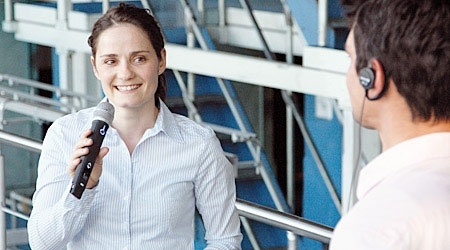Frequently Asked Questions
What is a tour guide system?
A tour guide system is a short range radio system used to transmit an audio message from a presenter to listeners. The presenter simply speaks into a radio microphone transmitter and the listeners use wireless lightweight receivers to hear the message. The system is usually recharged in a storage case.
Transmitters are available as either portable (handheld or bodypack) or fixed versions.
Portable transmitters
Handheld transmitters incorporate the microphone creating a one-piece device. These are generally used when multiple presenters are required to speak e.g. Interviews or questions and answer sessions, as it can be easily passed between people.
Bodypack transmitters are as the name suggests worn on the body by placing in a pocket, clipped to a belt or worn on a lanyard. All bodypack transmitters have at least one socket to enable an input to be connected. This is normally a microphone input but it can also often be used for an auxiliary input e.g. smartphone, laptop or any other device with a headphone socket. Various types of microphone are available to suit different applications. The most common is a headband microphone allowing the presenter to conduct the tour hands-free. Bodypack transmitters with integrated microphone and dual inputs, to enable a microphone and line (auxiliary) input to be used simultaneously, are also available from some manufacturers.
All portable transmitters have a microphone mute switch allowing the presenter to select when the microphone is “live”.
Fixed transmitter
Fixed transmitters operate from an external power source. Inputs can be from a microphone or line input (from audio equipment such as a CD player or sound system). These are generally used for larger systems such as sports arenas or conference rooms.
Receivers
Receivers (also known as headsets) are generally available in two types - bodypack or one-peice device.
Bodypack receivers have a standard 3.5mm jack socket to connect either; headphones (ideal for a noisy environment), earphones (lightweight for long tours) or an inductive neck loop (to assist hearing aid wearers). These receivers can be clipped onto a belt, worn on a lanyard or placed into a pocket during use.
One piece devices integrate the receiver into an earphone/headphone. These receivers do not require any additional items to operate and are quicker to distubute to and collect from the users, as there are no cables to untaggle. They also do not incuur the on going cost of replacing worn cables over time. The most common one peice receivers are the HDE 2020-D stethoset from Sennheiser and the TT 21-R earphone from Tourtalk.
All receivers have a volume control allowing each participant to individually adjust their volume to a comfortable level.
Transceivers
The transceiver incorporates a transmitter and receiver into a single bodypack unit. A transceiver enables full participation between the guide and the visitors as each person can communicate with the group. Each person is issued with a headset (comprising a microphone and headphone) to plug into their transceiver.

When are tour guide systems used?
Tour guide systems are used when normal conversation between a presenter and listeners is difficult. This could be due to distance, background noise, not wanting to disturb other people in the same environment or when communicating with a large group.
Examples of use
Tour guide systems can be used for tours conducted on the factory floor of businesses, so the guide doesn't have to shout and compete with noisy machinery when taking visitors around their facilities. Systems are also used for on-the-job staff training.
When tour guides are taking visitors or tourists around galleries, cathedrals or other noise sensitive environments tour guide systems are ideal. The guide simply whispers into the microphone and the users adjust their own volume on the receivers so everybody hears comfortably without disturbing others. As tour guide systems are radio based wireless systems, they also work outdoors. e.g. for castle tours, working farm tours, near noisy roads/airports or for audio descriptions for visually impaired people. Tour guide systems allow users freedom of movement while helping to keep the group together and stay focused.
Tour guide systems are used for simultaneous interpretation at international conferences. The wireless portable transmitter allows the translator to be mobile and to set up quickly without having to worry about the trip hazard of power leads. Or for larger systems, multiple fixed transmitters can be used enabling up to 32 languages to be translated.
For sports training when the coach needs to be heard by the participants. Tour guide systems can be used for equestrian, golf, shooting or any sport where the coach needs to be heard from a distance or without disturbing other people.
The wireless nature of tour guide systems makes them ideal as an assistive hearing or audio description system for stadiums and exhibitions centers. A tour guide system is a flexible and cost effective solution, as (usually) no installation is required. Bodypack receivers with either headphones or inductive neck loops (to assist hearing aid wearers) can be used, ensuring the event is more inclusive and complies with the Equality Act.
Fixed installation tour guide systems can be used in museums, galleries, stately homes or even bus/boat tours, as pre-recorded multi-lingual descriptions can be transmitted. The visitors listen to the guided commentary via their receiver as they move.
One-way or two-way?
Most tour guide systems only allow one-way communication. i.e. the guide speaks into a microphone transmitter and the visitors listen to the message via receivers with headphones. These system are generally cheaper to purchase and are easiest to use.
Two-way tour guide systems allow two-way communication i.e. each person is issued with a transceiver with microphone and headphones. This enables everybody on the tour to fully participate (with a maximum of six-people talking simultaneously). The tour guides can setup their transceivers as masters to interrupt at anytime and control the proceedings.
Hire or Buy?
Sound Induction Systems have a large stock of tour guide systems for hire. Hiring a system can be a cost effective solution for very occasional use. Many clients who hire then decide to purchase a system after experiencing the many benefits it brings to a tour. For regular events, clients normally purchase a system and then hire-in additional receivers if needed.
How easy are tour guide systems to use?
Tour guide systems are very easy to use without any prior experience of the equipment. Most systems are supplied in a charger/storage case. The presenter simply removes the microphone transmitter and switches it on. The receivers are then distributed to the listeners. The listeners then select the appropriate channel and adjust the volume to a comfortable level.
When the event has finished the receivers are collected and placed back into the charger/storage case ready for the next event.
Do I need a licence?
All the tour guide systems we supply are available in a licence-free version. Some manufacturers also have versions which require a licence. A licenced version maybe more suitable if the system is to be used in areas where other tour guide systems or radio microphones are in use, or for large systems where multiple channels (transmitters) are required. Licences are available for portable systems or fixed installations.

How many systems can be used together?
This depends on the manufacturer, but typically 4-20 channels transmitters can be used simultaneously licence-free. If more channels are required then a licenced (channel) system can be used enabling up to 32 channels to be used together.There is normally no limit to the amount of receivers that can be used on a tourguide system.
Do I need batteries?
Again this depends on the manufacturer and model. Some systems have integrated lithium batteries (similar to mobile phones) that require a dedicated charger/storage cases. Other systems use AA or AAA batteries so they can be used with rechargeable cells or (for very occasional use) alkaline batteries.
Are tour guide systems secure?
Most tour guide systems operate on standard analogue radio microphone channels that could be intercepted by commercially available scanners. For guided tours this is not normally an issue as the content is not confidential. However if the system is to be used for simultaneous interpretation at a conference this could cause security issues so a digitally encrypted system would be recommended.
What is the range of the system?
This depends on the system and conditions it is to be used in. Most systems have a maximum range of 120m when used outdoors. Range is approximately halved when used indoors.
Why choose us?
We only supply tour guide systems from major professional audio manufacturers that meet our stringent quality and cost-of-ownership standards. We have been trading (as Sound Induction Systems Ltd) since 1986 and have supplied systems to companies across the UK, Europe, Asia and Africa.
We pride ourselves on-
Unrivalled Quality Brands
Competitive Prices
Extensive Hire and Sales Stock
Reliable Service
Dedicated After Sales
For more information please contact us.
This page can be downloaded as a PDF here Tour guide systems



